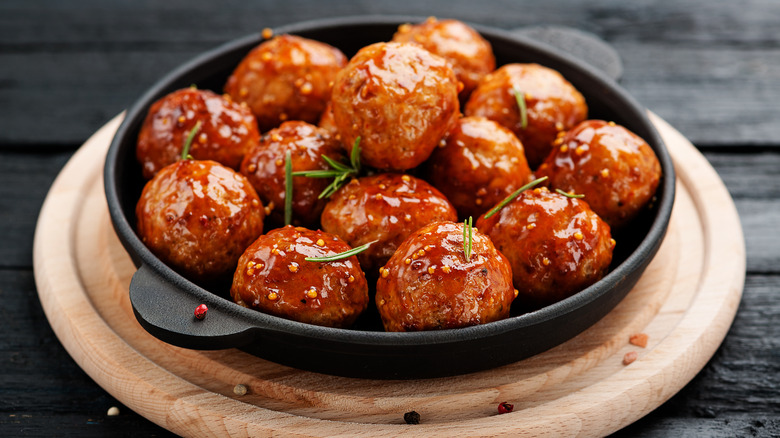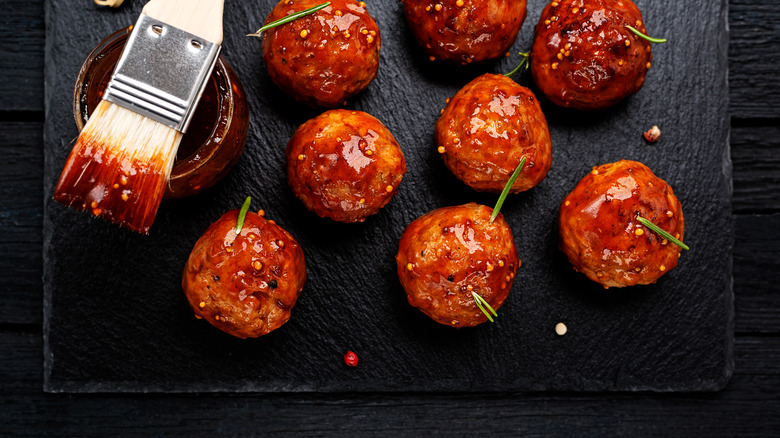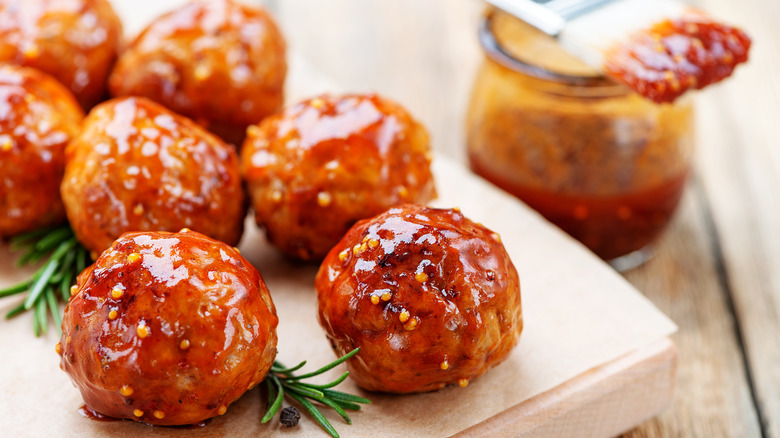Grape Jelly And Meatballs Have Been A Favorite Longer Than You Might Expect
If you feel like jelly only has a place in the world of sweet cooking, it's time to embrace its powers in enhancing savory dishes. For instance, strawberry jam provides a sweet key to Korean fried chicken's classic sauce, Yangnyeom — and think about the aromatic power that mint jelly can have on a leg of lamb. Grape jelly, too, has its place in the savory realm, making a tangy and sweet barbecue-like glaze destined to enhance nearly anything it touches, particularly meatballs.
Called grape jelly meatballs or cocktail meatballs, this recipe is a popular appetizer for tailgates and backyard barbecues — and has been for quite some time. A retro throwback to a time of cocktail weenies and cucumber canapés, jelly-accented glazed meatballs are often served in a slow cooker with toothpicks as the only form of utensil. But there's a long history hiding behind this classic dish and its unusual jelly-rich ingredient list, proving that multiple generations have seen its flavorful potential.
A legendary sweet and savory combo
Our tale of jelly and meatballs really kicks off in the 1960s, when cocktail hour hors d'oeuvres reigned supreme. One of the first published recipes arrived in 1962, when a woman submitted "Meatballs a la Twist" to the food column Dorothy Dean's Summer Recipes Contest. By 1967, the recipe had made its way into the "Elegant But Easy Cookbook," this time under the title of "Chafing Dish Meatballs." No matter the name, the dish always promised meatballs cooked and coated in a whimsical sauce comprised of half grape jelly and half chili sauce. Rolling into the 70s, the recipe continued to make the rounds in community cookbooks and even found its way into a 1978 edition of the "Betty Crocker Cookbook."
Its popularity fell off a bit in the 1980s and 90s, but it made a comeback in the new millennium thanks to the resurgence of the slow cooker. As mentioned before, one of the earliest recipes for grape jelly meatballs was often paired with the chafing dish, a tool that kept your food hot during serving. Soon, the slow cooker took over as an all-in-one cooking dish, warming dish, and serving dish for the meatballs.
So what exactly remains so eternal about this flavor combo? The sweetness of the grape jelly perfectly cuts the heat of the tomato-based chili sauce, making a spicy yet sweet glaze that calls to ming teriyaki sauce or a barbecue glaze — perfect for coating meatballs.
Make your own grape jelly meatballs
If you're ready to give this retro appetizer a try, there are several ways to go about it. For the simplest, most fuss-free recipe, you can choose your favorite brand of frozen meatballs and heat them in a slow cooker for three hours with a sauce made out of a cup of grape jelly and a cup and a half of chili sauce. You'll probably want to use a tomato-heavy brand of chili sauce like Heinz rather than a Southeast Asian chili sauce, which generally leads to much spicier results. You could also make a modern adjustment to the recipe and swap barbecue sauce for chili sauce; this may lead to a sweeter overall flavor, so consider cutting it with a dash of hot sauce. You can even use ketchup instead of barbecue sauce or chili sauce — just make sure you never skimp on the grape jelly.
For a more homespun recipe, you can make your own meatballs — but you'll want to sear them off to lock in flavor and juiciness before throwing them into the slow cooker. Consider making a garlic-heavy, well-spiced meatball to compliment the sweet jelly glaze. Whether you keep it fast and easy or add a homemade twist, you'll soon be aware of why this unusual flavor combo has charmed generations of cooks.


